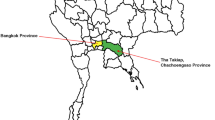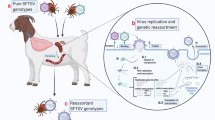Abstract
Severe fever with thrombocytopenia syndrome phlebovirus (SFTSV), listed in the most dangerous pathogens by the World Health Organization, has 12–30% fatality rates with a characteristic thrombocytopenia syndrome. With a majority of clinically diagnosed SFTSV patients older than ~50 years of age, age is a critical risk factor for SFTSV morbidity and mortality. Here, we report an age-dependent ferret model of SFTSV infection and pathogenesis that fully recapitulates the clinical manifestations of human infections. Whereas young adult ferrets (≤2 years of age) did not show any clinical symptoms and mortality, SFTSV-infected aged ferrets (≥4 years of age) demonstrated severe thrombocytopenia, reduced white blood cell counts and high fever with 93% mortality rate. Moreover, a significantly higher viral load was observed in aged ferrets. Transcriptome analysis of SFTSV-infected young ferrets revealed strong interferon-mediated anti-viral signalling, whereas inflammatory immune responses were markedly upregulated and persisted in aged ferrets. Thus, this immunocompetent age-dependent ferret model should be useful for anti-SFTSV therapy and vaccine development.
This is a preview of subscription content, access via your institution
Access options
Access Nature and 54 other Nature Portfolio journals
Get Nature+, our best-value online-access subscription
$32.99 / 30 days
cancel any time
Subscribe to this journal
Receive 12 digital issues and online access to articles
$119.00 per year
only $9.92 per issue
Buy this article
- Purchase on SpringerLink
- Instant access to full article PDF
Prices may be subject to local taxes which are calculated during checkout






Similar content being viewed by others
Data availability
The data that support the findings of this study are available from the corresponding authors upon request. The RNA-seq data were deposited in the Gene Expression Omnibus (GEO) under the accession number GSE121911.
References
Wiwanitkit, S. & Wiwanitkit, V. Acute viral hemorrhage disease: a summary on new viruses. J. Acute Dis. 4, 277–279 (2015).
Adams, M. J. et al. Changes to taxonomy and the International Code of Virus Classification and Nomenclature ratified by the International Committee on Taxonomy of Viruses (2017). Arch. Virol. 162, 2505–2538 (2017).
Kim, K.-H. et al. Severe fever with thrombocytopenia syndrome, South Korea, 2012. Emerg. Infect. Dis. 19, 1892–1894 (2013).
Takahashi, T. et al. The first identification and retrospective study of severe fever with thrombocytopenia syndrome in Japan. J. Infect. Dis. 209, 816–827 (2013).
SFTSV Infection in Korea (KCDC, 2016); http://cdc.go.kr/CDC/mobile/notice/CdcKrIntro0201.jsp?menuIds=HOME001-MNU1154-MN&fid=21&q_type=&q_value=&cid=73941&pageNum=1
NIID. Severe fever with thrombocytopenia syndrome (SFTS) in Japan, as of February 2016. IASR 37, 39–40 (2016).
Zhan, J. et al. Current status of severe fever with thrombocytopenia syndrome in China. Virol. Sin. 32, 51–62 (2017).
Li, D. Severe fever with thrombocytopenia syndrome: a newly discovered emerging infectious disease. Clin. Microbiol. Infect. 21, 614–620 (2015).
Baba, M. et al. Establishment of an antiviral assay system and identification of severe fever with thrombocytopenia syndrome virus inhibitors. Antivir. Chem. Chemother. 25, 83–89 (2017).
Disease Web Statistics System (KCDC, 2017); http://www.cdc.go.kr/npt/biz/npp/ist/bass/bassDissStatsMain.do
Epidemiologic and Clinical Characteristics of Severe Fever with Thrombocytopenia Syndrome in the Republic of Korea (KCDC, 2016); http://cdc.go.kr/CDC/together/CdcKrTogether0302.jsp?menuIds=HOME001-MNU1154-MNU0005- MNU0088&fid=51&q_type=title&q_value=SFTS&cid=69842&pageNum=
Caution of SFTS Infection at Outdoor Activity (KCDC, 2018); http://www.cdc.go.kr/npt/biz/npp/portal/nppSumryMain.do?icdCd=D0018&icdgrpCd=04&icdSubgrpCd=
2018 Annual Review of Diseases Prioritized Under the Research and Development Blueprint. WHO Research and Development Blueprint (WHO, 2018).
Pepin, M., Bouloy, M., Bird, B. H., Kemp, A. & Paweska, J. Rift Valley fever virus (Bunyaviridae: Phlebovirus): an update on pathogenesis, molecular epidemiology, vectors, diagnostics and prevention. Vet. Res. 41, 61 (2010).
Swei, A. et al. The genome sequence of Lone Star virus, a highly divergent bunyavirus found in the Amblyomma americanum tick. PLoS ONE 8, e62083 (2013).
Liu, Y. et al. The pathogenesis of severe fever with thrombocytopenia syndrome virus infection in alpha/beta interferon knockout mice: insights into the pathologic mechanisms of a new viral hemorrhagic fever. J. Virol. 88, 1781–1786 (2014).
Chen, X.-P. et al. Infection and pathogenesis of Huaiyangshan virus (a novel tick-borne bunyavirus) in laboratory rodents. J. Gen. Virol. 93, 1288–1293 (2012).
Jin, C. et al. Pathogenesis of emerging severe fever with thrombocytopenia syndrome virus in C57/BL6 mouse model. Proc. Natl Acad. Sci. USA 109, 10053–10058 (2012).
Liu, S. et al. Systematic review of severe fever with thrombocytopenia syndrome: virology, epidemiology, and clinical characteristics. Rev. Med. Virol. 24, 90–102 (2014).
Jin, C. et al. SFTS virus infection in nonhuman primates. J. Infect. Dis. 211, 915–925 (2014).
Yun, S.-M. et al. Molecular genomic characterization of tick-and human-derived severe fever with thrombocytopenia syndrome virus isolates from South Korea. PLoS Negl. Trop. Dis. 11, e0005893 (2017).
Sun, J. et al. Factors associated with severe fever with thrombocytopenia syndrome infection and fatal outcome. Sci. Rep. 6, 33175 (2016).
Smith, S. A., Zimmerman, K. & Moore, D. M. Hematology of the domestic ferret (Mustela putorius furo). Vet. Clin. North Am. Exot. Anim. Prac. 18, 1–8 (2015).
Hein, J., Spreyer, F., Sauter-Louis, C. & Hartmann, K. Reference ranges for laboratory parameters in ferrets. Vet. Rec. 171, 218 (2012).
Li, S. et al. Multiple organ involvement in severe fever with thrombocytopenia syndrome: an immunohistochemical finding in a fatal case. Virol. J. 15, 97 (2018).
Hiraki, T. et al. Two autopsy cases of severe fever with thrombocytopenia syndrome (SFTS) in Japan: a pathognomonic histological feature and unique complication of SFTS. Pathol. Int. 64, 569–575 (2014).
Park, S.-J. et al. Dynamic changes in host gene expression associated with H5N8 avian influenza virus infection in mice. Sci. Rep. 5, 16512 (2015).
Shimada, S., Posadas-Herrera, G., Aoki, K., Morita, K. & Hayasaka, D. Therapeutic effect of post-exposure treatment with antiserum on severe fever with thrombocytopenia syndrome (SFTS) in a mouse model of SFTS virus infection. Virology 482, 19–27 (2015).
Kaneko, M. et al. A patient with severe fever with thrombocytopenia syndrome and hemophagocytic lymphohistiocytosis-associated involvement of the central nervous system. J. Infect. Chemother. 24, 292–297 (2018).
Deng, B. et al. Cytokine and chemokine levels in patients with severe fever with thrombocytopenia syndrome virus. PLoS ONE 7, e41365 (2012).
Liu, J. et al. Dynamic changes of laboratory parameters and peripheral blood lymphocyte subsets in severe fever with thrombocytopenia syndrome patients. Int. J. Infect. Dis. 58, 45–51 (2017).
Acknowledgements
This work was supported by the Korea Health Technology R&D Project, funded by the Ministry of Health & Welfare, Republic of Korea (HI15C2817), National Research Foundation of Korea (NRF-2017K2A9A1A01092932) to Y.K.C., National Institute of Health (AI129496, AI40718 and AI140705) to J.U.J. and the Ministry of Health & Welfare, Republic of Korea (HI15C2888) to M.-S.S. We thank I.-P. Mo and K.-S. Kim (College of Veterinary Medicine, Chungbuk National University) for their kind support in the immunohistochemistry assay and the haematoxylin and eosin histopathological study.
Author information
Authors and Affiliations
Contributions
S.-J.P., Y.-I.K. and Y.K.C. conceptualized the study. S.-J.P., Y.-I.K., H.-I.K., E.-H.K., Y.-J.S., C.-H.L., A.P., K.J., W.-J.S., M.-S.S., Y.C. and J.Z. conducted the investigation. S.-J.P., J.U.J. and Y.K.C. wrote the paper.
Corresponding authors
Ethics declarations
Competing interests
The authors declare no competing interests.
Additional information
Publisher’s note: Springer Nature remains neutral with regard to jurisdictional claims in published maps and institutional affiliations.
Supplementary information
Supplementary Information
Supplementary Figures 1–10.
Rights and permissions
About this article
Cite this article
Park, SJ., Kim, YI., Park, A. et al. Ferret animal model of severe fever with thrombocytopenia syndrome phlebovirus for human lethal infection and pathogenesis. Nat Microbiol 4, 438–446 (2019). https://doi.org/10.1038/s41564-018-0317-1
Received:
Accepted:
Published:
Issue date:
DOI: https://doi.org/10.1038/s41564-018-0317-1
This article is cited by
-
Kinetically activating nanovaccine mimicking multidimensional immunomodulation of natural infection for broad protection against heterologous viruses in animal models
Nature Communications (2025)
-
Multiscale dynamic immunomodulation by a nanoemulsified Trojan-TLR7/8 adjuvant for robust protection against heterologous pandemic and endemic viruses
Cellular & Molecular Immunology (2025)
-
Prognostic nutritional index as an early predictor of mortality in patients with severe fever with thrombocytopenia syndrome: multicenter retrospective study in South Korea
BMC Infectious Diseases (2025)
-
Construction and validation of a dynamic nomogram using Lasso-logistic regression for predicting the severity of severe fever with thrombocytopenia syndrome patients at admission
BMC Infectious Diseases (2024)
-
Severe fever with thrombocytopenia syndrome with central nervous system symptom onset: a case report and literature review
BMC Neurology (2024)



